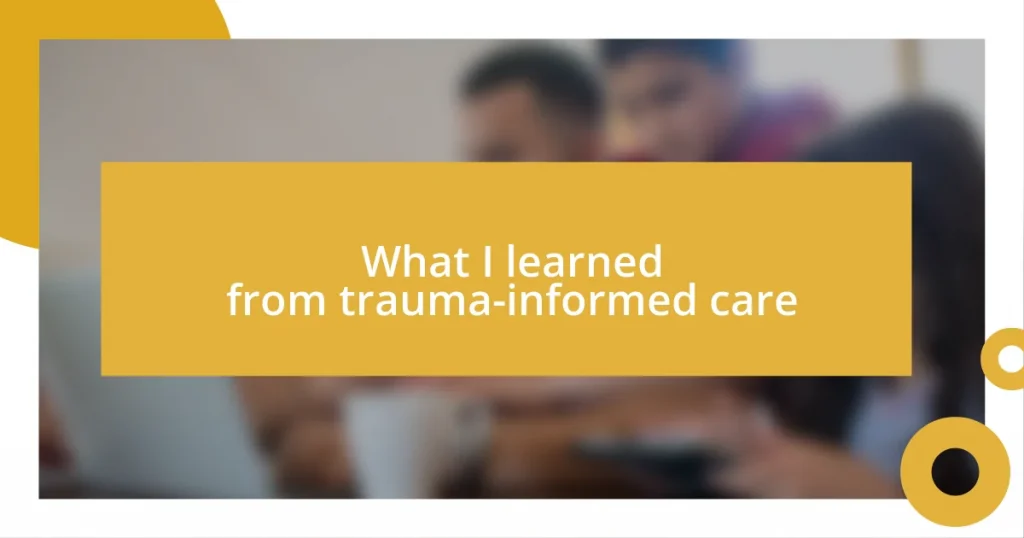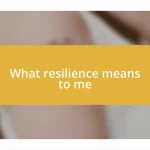Key takeaways:
- Trauma-informed care emphasizes the importance of understanding individuals’ past experiences to foster safety, trust, and empowerment in their healing journey.
- Awareness of trauma leads to more empathetic interactions, enhancing relationships and encouraging openness in conversations about personal challenges.
- Integrating strengths-based approaches and practical strategies, such as safety plans and holistic techniques, empowers individuals and promotes significant personal growth.

Understanding trauma-informed care principles
Trauma-informed care (TIC) is centered around understanding the impact of trauma on individuals and recognizing how it shapes behaviors and responses. I remember a time when a colleague shared their struggle with clients who seemed unresponsive. Reflecting on it later, I realized that without understanding their past experiences, we might overlook crucial factors that influence their current mindset. Isn’t it crucial to consider what someone has been through before judging their actions?
At its core, TIC principles encourage safety, trustworthiness, and empowerment. I once worked with a group of individuals recovering from addiction, and the difference was palpable when we prioritized creating a safe space. People began to open up, share their stories, and take ownership of their healing. It made me think: How often do we assume that everyone feels safe in our environments?
One essential principle is collaboration, emphasizing the importance of working alongside the individual rather than doing things for them. I recall a time when I asked a client for their input on their treatment plan, and their eyes lit up with surprise and appreciation. It made me realize that involving people in their care fosters a sense of agency. Isn’t it amazing how a small gesture like asking for someone’s opinion can transform their experience?

Importance of awareness in trauma
Awareness of trauma is paramount in providing effective care. I vividly remember a workshop where we discussed the signs of trauma in clients. The simple act of recognizing these signs transformed my approach—suddenly, I was equipped to respond with empathy instead of frustration. It’s fascinating how this shift not only changed my perspective but also significantly improved client interactions. Have you ever thought about how awareness can reshape your understanding of someone’s behavior?
When we’re aware of the prevalence of trauma, we create a culture that embraces healing and understanding. I once facilitated a support group for parents dealing with childhood trauma, and I noticed how just mentioning the word “trauma” made the room feel lighter. It sparked conversations, allowing individuals to share their stories, and reminded me of the collective burden many carry. Isn’t it powerful how acknowledging trauma can break isolation?
Moreover, trauma awareness enables us to build stronger, more compassionate relationships. Reflecting on my experience, I think back to a client who would often lash out during our sessions. After learning more about their background, I approached them differently—starting from a place of love instead of judgment. This simple shift opened the door to deeper conversations about their past. This leads to the question: Can understanding someone’s trauma ultimately change the dynamics of any relationship we have?
| Awareness | Impact |
|---|---|
| Recognizing trauma signs | Improves empathetic responses |
| Cultivating understanding | Encourages openness and sharing |
| Building compassionate relationships | Deepens connections and trust |

Building trust with individuals
Building trust with individuals is often a slow and deliberate process. I recall my initial encounters with a young woman who was visibly guarded during our sessions. I realized that her reluctance stemmed from previous painful experiences. By simply taking the time to listen without judgment and acknowledging her feelings, I started to see cracks in her defenses. With each conversation, I felt the trust beginning to build, revealing a chance for deeper healing.
Establishing a trusting relationship hinges on being transparent and consistent. I always try to communicate my intentions clearly and ensure that individuals know they have a safe space to express themselves. Here’s what helps me foster that trust:
- Active Listening: I focus entirely on what the individual is saying, which shows I value their perspective.
- Respecting Boundaries: I always check in before delving into sensitive topics, letting them control the pace of our sessions.
- Honesty: I share my own experiences when appropriate. This vulnerability can help bridge the gap and humanize our interactions.
- Consistency: Being reliable in our interactions shows that I’m committed to their journey and care about their well-being.
Each step taken in support of building trust can lay the groundwork for meaningful conversations and healing. I’ve witnessed how trust transforms interactions, turning once reluctant individuals into engaged participants in their own healing journey.

Integrating strengths-based approaches
Integrating strengths-based approaches is all about shifting the lens through which we view individuals. I remember a particular case where I worked with a young man who had faced numerous setbacks in life. Instead of focusing solely on his challenges, I made a conscious effort to highlight his resilience and skills. He seemed surprised yet invigorated when I reflected back to him all the strengths he possessed. Can you think of someone in your life who has hidden strengths just waiting to be acknowledged?
When we adopt this strengths-based perspective, we empower those we work with to take ownership of their journeys. A few weeks ago, I guided a workshop that emphasized identifying personal strengths. Participants discovered talents and resources they hadn’t recognized before. It was amazing to witness the transformation in their demeanor—suddenly, they were energized and motivated. This leads me to wonder, isn’t it fascinating how recognizing potential can spark a remarkable change in one’s outlook?
Moreover, I have found that integrating strengths-based approaches often creates a ripple effect, impacting relationships in profound ways. For instance, in my sessions, I started asking clients how they would use their strengths to overcome specific challenges rather than just discussing these challenges themselves. This method sparked creativity and hope. Have you ever noticed how focusing on what someone can do opens new pathways for growth? It’s as if a light bulb turns on, illuminating possibilities that were previously hidden in the shadows of trauma.

Practical strategies for effective support
One effective strategy I’ve found is to create a safety plan with individuals I support. I recall working with a client who frequently felt overwhelmed in stressful situations. By collaborating with them to outline specific steps they could take when anxiety struck, I noticed a significant shift in their confidence. It’s empowering for individuals to see that they can control some aspects of their emotional responses. Have you thought about the comfort a safety plan could bring to someone feeling lost in their trauma?
Additionally, adopting a holistic approach can be incredibly beneficial. During my work with groups, I’ve often integrated relaxation techniques—like breathing exercises or mindfulness practices. Once, I led a session where we all practiced deep breathing, and I saw immediate relief wash over participants. It was a simple act, yet witnessing their stress melt away reinforced my belief in the power of such techniques. It makes me wonder, how often do we underestimate the relief that can come from just pausing to breathe?
Lastly, I prioritize regular check-ins to assess both progress and emotional well-being. In my experience, these moments of reflection are goldmines for insight. For instance, I’ve used journaling prompts during these check-ins to help individuals articulate their feelings. I distinctly remember a client who, after a few sessions, found clarity in their thoughts and emotions that had been clouded for so long. It’s fascinating how the simple act of putting pen to paper can unlock such profound revelations. Have you ever noticed how writing can serve as a form of therapy for many? It truly is remarkable.

Measuring outcomes of trauma-informed care
Measuring outcomes in trauma-informed care can be quite challenging but incredibly rewarding. I remember a time when I was asked to evaluate a program aimed at helping adolescents affected by trauma. The sheer joy I felt when I saw the statistical improvement in their resilience scores was unforgettable. These numbers don’t just represent data; they are proof of the individuals’ journeys toward healing. How does it feel to observe change not just in numbers, but in smiles and newfound confidence?
Qualitative assessments are equally important in gauging the effectiveness of trauma-informed care. One experience stands out in my mind—a focus group where individuals shared their personal stories of transformation. Listening to their heartfelt testimonies about feeling safe and understood reaffirmed my belief in the impact of validating experiences. Have you ever listened to someone recount their struggles, only to realize how powerful it is to bear witness to their healing process?
Combining both quantitative and qualitative measures offers a holistic view of progress. In my practice, I often utilize pre- and post-intervention surveys alongside personal narratives to evaluate outcomes. I once compiled a report from these reflections and found profound insights about resilience and hope that numbers alone could never capture. It’s amazing to think about how understanding clients’ narratives can deepen our understanding of their healing. Isn’t it enlightening to realize that both data and stories could together paint the complete picture of transformation?














